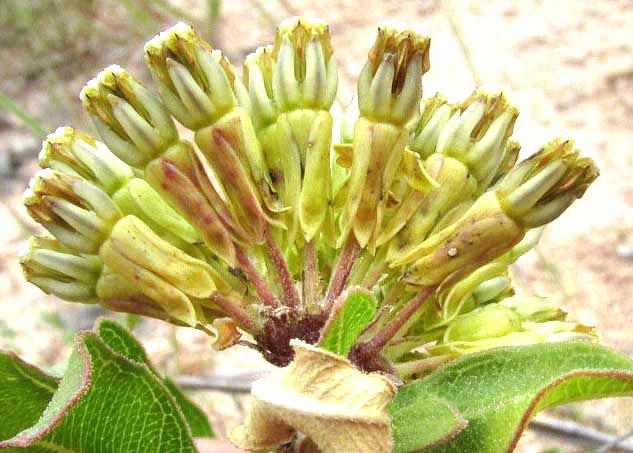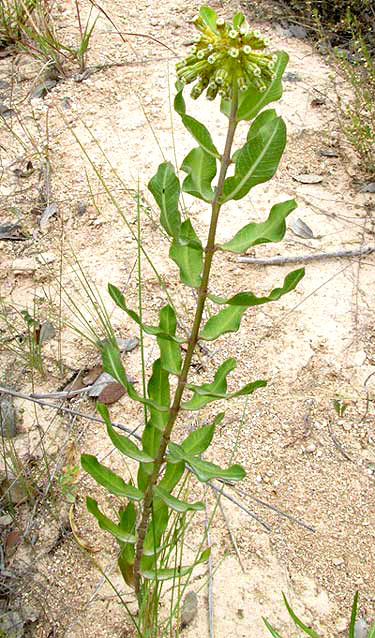Excerpts from Jim Conrad's
Naturalist Newsletter

from the August 24, 2014 Newsletter issued from the Frio Canyon Nature Education Center in the valley of the Dry Frio River in northern Uvalde County, southwestern Texas, on the southern border of the Edwards Plateau; elevation ~1750m (~5750 ft); N29.62°, W99.86°; USA
GREEN MILKWEED
In dry, marly dirt deposited by runoff from decaying limestone, a knee-high milkweed looked fairly healthy, despite the severity of our drought. It's shown at the right.

The plant was easily identifiable as a milkweed not only because many milkweed species have opposite leaves (two per stem node) like these, which exude milky juice when injured, but also because the flower structure was very distinctly milkweed, as seen at the top of this page.
One way in which milkweed flowers are so unusual is that their flowers are adapted for a particular kind of pollination in which waxy pollen gathers and hardens into V-shaped structures called pollinia, which snag onto pollinators' legs. The pollinators then carry the pollinia to other flowers. Milkweed flower anatomy is so unique among all flowering plants that I provide a special page explaining them at http://www.backyardnature.net/fl_milkw.htm.
Usually we think of milkweed flowers as white or variously red to pink to purplish, so these greenish flowers are a little unusual. However, several milkweed species can produce greenish flowers and sometimes are known as Green Milkweed, so to know which Green Milkweed we have, we have to "do the botany."
Among the features helping us figure out which Green Milkweed this is are these:
# The plant's leaves are somewhat broad, not at all threadlike, and mostly opposite (two per stem node). Also they tend to bend upward, and are somewhat hairy, especially below.
These and other features point us to the Green Milkweed bearing the binomial ASCLEPIAS VIRIDIFLORA. Besides Green Milkweed it's also known as Green Comet Milkweed, Green Antelopehorn Milkweed, Green-flowered Milkweed, and by other names. The species fairly commonly is encountered throughout the eastern and central US, and contiguous Mexico.
Milkweeds are called milkweeds because when injured they issue milky-white latex containing a rich mixture of chemical compounds, some of which may be toxic or medicinal, depending on their dosage. Indigenous Americans chewed our Green Milkweed's roots to make a poultice that could be applied to rashes, a nursing baby's sore gums, rheumatic joints, and sore eyes. The root was chewed to relieve the sore throat, and infusions of the root have been used to treat diarrhea in children. As often is the case with plants producing milky exudates -- in accordance with the baseless Doctrine of Signatures, which states that plants signify to us their uses with features of their appearance -- infusions of the plant have been used to increase the milk flow of nursing mothers.
While I'd hesitate to use raw milkweed products medicinally, because of the inability to control dosages of the many potentially toxic compounds, the plants' unopened flower buds, immature leaves, and newly emerged sprouts can be cooked and eaten, but the water in which they are cooked should be discarded.
But, it'd be a shame to eat this or any other milkweed species. They are important nectar sources to many pollinators, Monarch Butterfly larvae eat their leaves, and they're simply too pretty to eat. Milkweeds have suffered greatly because of rampant, thoughtless mowing and herbicide use.